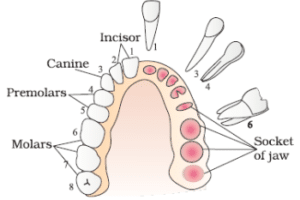DIGESTION AND ABSORPTION
- Food is one of the basic requirements of all living organisms.
- The major components of our food are carbohydrates, proteins and fats. Vitamins and minerals are also required in small quantities. Food provides energy and organic materials for growth and repair of tissues. The water we take in, plays an important role in metabolic processes and also prevents dehydration of the body.
- Biomacromolecules in food cannot be utilised by our body in their original form. They have to be broken down and converted into simple substances in the digestive system.
- This process of conversion of complex food substances to simple absorbable forms is called digestion and is carried out by our digestive system by mechanical and biochemical methods
The human digestive system consists of the alimentary canal and the associated glands
Carbohydrates, proteins and fats are major components of our food. Vitamins and minerals are also required in small quantities
- Digestion is conversion of complex food substances i.e. biomacromolecules into simple absorbable forms and is carried out by our digestive system by mechanical and biochemical methods.

Alimentary canal
- Its anterior opening is mouth and posterior opening is anus. Mouth leads to buccal cavity or oral cavity which has a number of teeth and a tongue.
Teeth
These are embedded in sockets of jaw bone (thecodont). Majority of mammals including human being have two sets of teeth during their life, i.e temporary milk or deciduous teeth and permanent or adult teeth. This type of dentition is called diphyodont.
An adult human has 32 permanent teeth which are of four different types (Heterodont dentition), namely,
incisors (I), canine (C), premolars (PM) and molars (M).
Arrangement of teeth in each half of the upper and lower jaw in the order I, C, PM, M is represented by a dental formula which in human is 2123 / 2123. The hard chewing surface of the teeth, made up of enamel, helps in the mastication of food.

Tongue
It is freely movable muscular organ attached to the floor of the oral cavity by the frenulum.
Its upper surface has small projections called papillae, some of which bear taste buds.
Tongue
Oral cavity leads into a short pharynx (common passage for food and air). Oesophagus and trachea (wind pipe) open into pharynx.
A cartilaginous flap called epiglottis prevents the entry of food into the glottis (it is opening of the wind pipe) during swallowing.
Oesophagus
It is a thin, long tube which passes through neck, thorax and diaphragm and leads to a ‘J’ shaped bag like structure called stomach. Opening of oesophagus into stomach is regulated by Gastro-oesophageal sphincter
Stomach
- It is located in the upper left portion of the abdominal cavity. It has three major parts – a cardiac portion into which the oesophagus opens, a fundic region and a pyloric portion which opens into the first part of small intestine.

Small Intestine
- It has three regions, a ‘U’ shaped duodenum, a long coiled middle portion jejunum and a highly coiled ileum. Ileum opens into the large intestine. The opening of the stomach into the duodenum is guarded by the pyloric sphincter.
Large Intestine
It consists of caecum, colon and rectum.
Caecum is a small blind sac which hosts some symbiotic micro-organisms, It has a narrow finger-like tubular projection, the vermiform appendix (vestigial organ),
Caecum opens into colon which is divided into three parts – an ascending, a transverse and a descending part. The descending part opens into the rectum which opens out through the anus.
DIGESTION AND ABSORPTION | Alimentary canal | Small Intestine | Large Intestine
Histology of Alimentary canal
Wall of alimentary canal from oesophagus to rectum has four layers namely serosa, muscularis, sub-mucosa and mucosa.
1-Serosa is the outermost layer and is made up of a thin mesothelium with some connective tissues.
2-Muscularis is formed by smooth muscles usually arranged into an inner circular and an outer longitudinal layer. An oblique muscle layer may be present in some regions.
3-Submucosa is formed of loose connective tissues containing nerves, blood and lymph vessels. In duodenum, glands are also present in sub-mucosa.
4-Mucosa is the innermost layer lining the lumen of the alimentary canal. It forms irregular folds (Gastric rugae) in the stomach and small finger-like foldings called villi in the small intestine
The cells lining the villi produce numerous microscopic projections called microvilli giving a brush border appearance. These increase surface area enormously.
- Villi are supplied with a network of capillaries and a large lymph vessel called the lacteal. Mucosal epithelium has goblet cells which secrete mucus that help in lubrication.
Mucosa also forms glands in the stomach (gastric glands) and crypts in between the bases of villi in
the intestine (crypts of Lieberkuhn).
